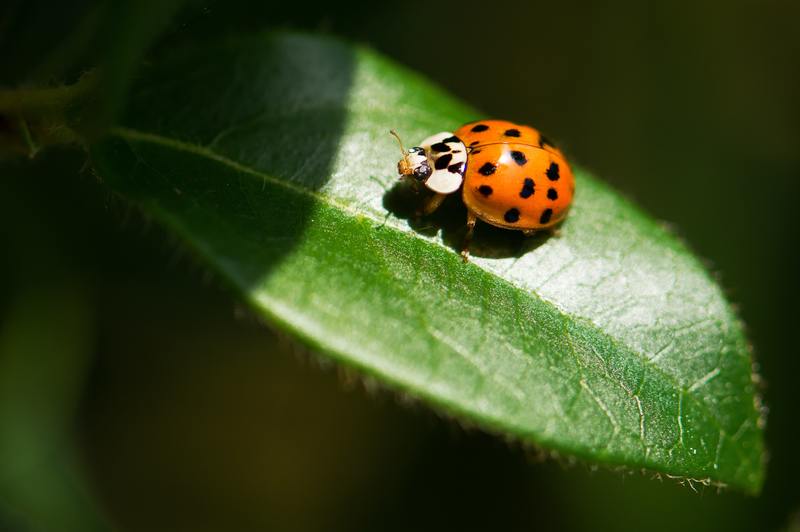Ladybugs make great natural pest control, and as such, consumers are wondering how to use ladybugs for pest control. This guide will clear your inquiries and provide you with easy-to-follow tips!
Ladybugs (lady beetles) are a popular biological control tool used by many gardeners and landscape aficionados. However, there are a few things to consider if you want to have a good ladybug discharge in your garden or terrain.

What Are Ladybugs?
Ladybugs, like many other insects or animals, are a misnomer. It’s a beetle, not a bug.
The ladybird beetle, as it’s called in Europe, was named after the Virgin Mary in the Middle Ages, according to legend.
They are now found in practically every section of North America, with over 400 different species, 98 of which live in Florida alongside retirees and other sun seekers. Entomologists have discovered over 4,500 species around the world.
It’s no wonder that ladybugs appear in a variety of shapes and sizes, given their large number of varieties. When we think of “ladybug,” we usually picture a red-orange critter with black dots.
The number of spots, though, can differ, and some are more clumped than spot-like, while others have stripes instead of spots.
What You Need To Know About Ladybugs For Pest Control
Ladybugs are predators that subsist by eating other insects. Ladybugs eat aphids, mealybugs (both sap-sucking insect pests), insect eggs, tiny caterpillars, and mites in this example.
For a more thorough explanation on this, check the useful gardening tips on these articles on how to remove aphids from kale and how to get rid of aphids in your greenhouse. Make good use of your little pest control helpers.
The convergent ladybug is the most often purchased ladybug (Hippodamia convergens). They have two white lines slanting towards each other on the top of their heads, as though they’re merging.
If you release ladybugs in your landscape because you enjoy watching them, but there are no insects for them to eat, the ladybugs will look for food elsewhere, leaving you with an empty bag.
So, what can you do to increase the success of your plan once you have released the ladybugs? Prepare to jot down the tips in the next section.
How To Have A Successful Ladybug Release
Ladybugs are collected in hibernating locations and kept in cold storage until they are ready to be released. Ladybugs should be stored in a refrigerator until they’re ready to be released.
It helps them live longer, and when it’s time for them to fly and be free, you’ll have fewer deaths. Ladybugs’ first instinct is to scatter and hunt food and water to restore their energy stores once they have warmed up.
If you distribute ladybugs during the day, they will scatter from your landscape, leaving you heartbroken and wondering where they all went!
This is the primary tip among people who want to achieve a successful ladybug release. However, there are more to keep in mind!
- Put the ladybug container near plants that have a lot of pest insects (aphids, mealybugs), so the ladybugs can feed and lay eggs on them.
- When the weather is cooler, disperse ladybugs in the early evening. Try opening their container and placing it under a box for the night.
- Sprinkle the nearby plants with water to keep them hydrated while they acclimate to the region. A spritz of water isn’t essential if there is dew.
Some experts even suggest spritzing water within their container instead of spraying it on the plants.
- Place an index card near the ladybug container with some falls of honey on it and leave it overnight. Ladybugs will take honey as a rapid source of energy until they are ready to eat aphids.
Ladybugs can be purchased from local nurseries or online sources. If you’re heading to a local nursery, make sure they have ladybugs for sale.
If you follow these simple steps, you might be able to keep those ladybugs in your garden for a little longer!
How Do Ladybugs Survive Winter
The mature beetle emerges into the world after spending around two weeks, or sometimes less, within their cocoon. Adult beetles have a lifespan of about three years.
They will deposit eggs and produce multiple new generations throughout this time. As a result, beetles in a group could be of various ages.
Adult beetles depart their feeding places in yards, fields, and forests in the fall to hibernate for the winter. They require a huddle of hundreds or thousands of other beetles in order to survive.
This keeps them safe from the elements and prevents them from freezing. They’ll also make winter homes in gaps, nooks, tree bark, and even your house or roof.
They may land on you and immediately begin crawling. Other times, however, they can really fly around.
Scientists have recorded ladybird beetles moving at a speed of 37 miles per hour.
Conclusion
You can definitely use your knowledge on how to use ladybugs for pest control to your advantage. Through this, you can avoid harmful consequences plus you have perfectly got rid of pests!
